A Couple’s Journey to Explore and Protect the BWCAW
Story and photos by Dave & Amy Freeman
“You know, a year is a really long time! You probably won’t eat any of this while you’re out there,” exclaimed a friend as he piled another helping of quiche on my plate.
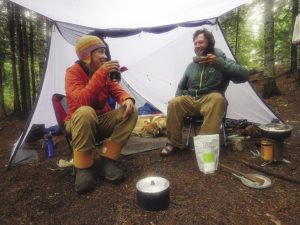
It was the Fall Equinox, September 23, 2015 and my wife, Amy Freeman, and I were having breakfast at our friend Jason’s house outside Ely. In a few hours we would paddle into the Boundary Waters Canoe Area Wilderness for an entire year and it seemed like everything was happening for the last time. It would be a year before we climbed out of a bed, took showers, went inside a building, or drove a car. As the earth made a full rotation around the sun, our senses would slowly become attuned to the wilderness, unveiling a whole new world of thoughts, emotions and experiences. We would experience the changing seasons in a unique way and be forever changed when we left the wilderness 366 days later
But first, we had to make it into the wilderness. The endless checklists, cramming of boxes into storage, and last minute details that all seemed so necessary left little time for sleep in the weeks leading up to our departure. When my head finally hit the pillow the night before leaving civilization, numbers, facts, figures, checklists, thoughts and worries left me feeling sleepless and numb.
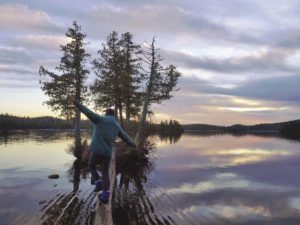
beam at sunrise.
We portaged across the invisible wilderness boundary along the South Kawishiwi River. The smell of fall filled our nostrils and golden birch leaves covered the forest floor. We paddled a few miles, set up our tent in a cool drizzle, and fell into a deep sleep. It would take several days to recover from lost sleep, a few weeks to settle into life in the Wilderness, and many months for all our senses to become heightened, but our journey had begun.
Fall in canoe country is pure joy. Bugs and summer’s relative crowds are a distant memory. High overhead, Canada geese stream purposefully south, beavers coat their lodges in a fresh layer of mud, and the low, rhythmic call “errrh…errrh…errrh” of a female moose searching for its mate breaks the silence. The days grew shorter, but fall seemed like it would last forever.
We celebrated Thanksgiving a day early. The weather was so nice that we transformed our overturned canoe into a table and enjoyed our feast outside. We stuffed ourselves with potatoes, stuffing, cranberries, cornbread, and many of the familiar holiday foods we would normally eat with friends and family in a very different setting, but we were thankful for many of the same things. Wilderness helped us strip away noise and distractions and helped us see clearly what matters most. Water, warmth, shelter, food, love, courage, purpose—these are the things we gave thanks for.
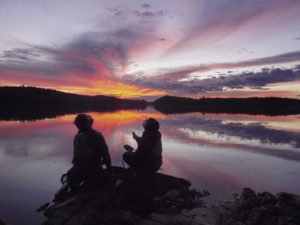
Skim ice began to form in the protected bay behind our camp. The singing ice signaled it was time to go and the last of the loons disappeared. Winter was late, but by early December the shallower lakes and bays were starting to freeze. From our campsite on Knife Lake, which is one of the deepest lakes in the canoe country, we could still paddle for many miles in either direction. It was fun to paddle up and down the lake gathering firewood, checking the ice on the smaller lakes, and generally feeling like we were cheating winter.
Our food barrels were getting light and the late freeze-up meant we would need to tighten our belts and ration food. We needed to move towards the edge of the wilderness in hopes that volunteers could bring us more food when the ice was safe.
Our hearts sank when we reached Vera Lake. The ice was too thick to paddle through and too thin to hold us, we would have to wait. That evening, a pack of wolves ran past our camp. Excited, we listened to them bark and whine no more than 100 feet from our tent. In the morning, the ice was barely thick enough for us to walk across. We followed the wolf tracks for many miles as we cautiously towed our canoe across Vera and Ensign Lake.
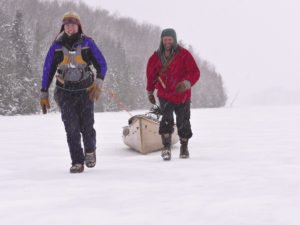
The temperatures moderated, leaving the lakes in limbo. We were stuck on an island, busying ourselves gathering wood, giving haircuts, mending equipment, and just being a part of the landscape and the earth’s slow orbit. With the New Year came visitors, real winter and sled dogs. Friends hauled our canoe out and our transition to winter was complete. Deep snow, steep hills and slush would bog us down many times, but on the first day we flew. Sled dogs Acorn, Tina and Tank leaned into their harnesses and behind them trailed our two toboggans. A thin layer of unbroken snow was perfect for travel. We laughed and skied along, trying to keep up with the dogs. Life was good; few things bring us as much joy as working alongside sled dogs.
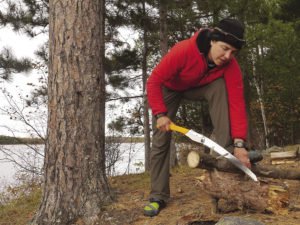
We spent hours gathering firewood to fill our woodstove and heat our tent. We watched wolves trot across lakes and were startled by grouse exploding from their snowy burrows. We slowed down, moving camp once or twice a week and taking more day trips skijoring with the dogs.
As the days grew longer and spring arrived, we said goodbye to Tina and Acorn and switched back to our canoe, but Tank stayed with us. Once again, we were hauling our canoe across the ice, but this time it was melting. The days were long, the birds were returning, and life was getting easier.
We invented a new sport, Boundary Waters Bobsledding, paddling across open stretches, then slid up onto firm ice like an otter when the ice reappeared. It was challenging and at times scary, but oftentimes those are the moments that teach us the most and remain etched in our memories.
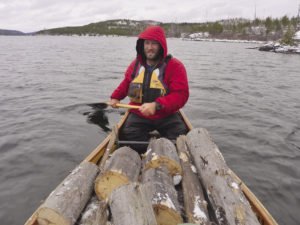
Many of our chores melted away with the ice. Spring meant taking pictures without gloves, writing in our journals in the sun, and many simple pleasures that we learned to appreciate after a winter of dark and cold. We rejoiced with the return of the songbirds—and the loons quickly followed. Moose calves shadowed their mothers, searching for food in the shallows and lake trout sizzled in our frying pan to be replaced by walleye as the water warmed. Soon, swimming and visitors were common and time slipped past.
Hints of yellow and red dotted the forest. The air felt cool for the first time in many months and our year in the wilderness was about to end. Life was normal and it was funny to realize we were more nervous about leaving the wilderness than we had been about entering it.
Many people thought the winter would offer our biggest challenge. In truth, life in the wilderness is harder in the winter, but it wasn’t the cold that we were worried about; we had worked as dogsledding guides for Wintergreen Dogsled Lodge for many years and there are no bugs. We love winter! It may sound silly, but our biggest concern was that people would forget about us.
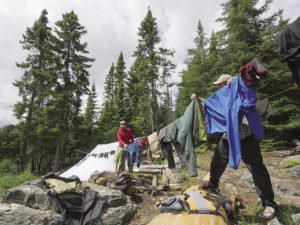
The goal of our journey was to raise awareness about a series of sulfide-ore copper mines being proposed along the edge of the wilderness near Ely. Peer-reviewed science, including a recently published study in the Journal of Hydrology (Feb. 2016), conclude that a mine built in this location would pollute the wilderness. Our jobs and our way of life depend on the wilderness, so we partnered with the Campaign to Save the Boundary Waters in hopes of using our journey to inspire people to take action and help protect the wilderness.
Luckily, people didn’t forget about us. In fact, we had over 300 people volunteer to bring us supplies during every season, including far more chocolate bars than two people should ever eat in a year. Thousands of others wrote letters, signed petitions, and join us in taking action. You can learn more at www.savetheboundarywaters.org/wildernessyear.


